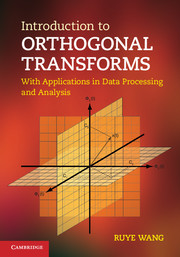Book contents
- Frontmatter
- Contents
- Preface
- Acknowledgments
- Notation
- 1 Signals and systems
- 2 Vector spaces and signal representation
- 3 Continuous-time Fourier transform
- 4 Discrete-time Fourier transform
- 5 Applications of the Fourier transforms
- 6 The Laplace and z-transforms
- 7 Fourier-related orthogonal transforms
- 8 The Walsh-Hadamard, slant, and Haar transforms
- 9 Karhunen-Loève transform and principal component analysis
- 10 Continuous- and discrete-time wavelet transforms
- 11 Multiresolution analysis and discrete wavelet transform
- Appendices
- Bibliography
- Index
2 - Vector spaces and signal representation
Published online by Cambridge University Press: 05 October 2012
- Frontmatter
- Contents
- Preface
- Acknowledgments
- Notation
- 1 Signals and systems
- 2 Vector spaces and signal representation
- 3 Continuous-time Fourier transform
- 4 Discrete-time Fourier transform
- 5 Applications of the Fourier transforms
- 6 The Laplace and z-transforms
- 7 Fourier-related orthogonal transforms
- 8 The Walsh-Hadamard, slant, and Haar transforms
- 9 Karhunen-Loève transform and principal component analysis
- 10 Continuous- and discrete-time wavelet transforms
- 11 Multiresolution analysis and discrete wavelet transform
- Appendices
- Bibliography
- Index
Summary
In this chapter we discuss some basic concepts of Hilbert space and the related operations and properties as the mathematical foundation for the topics of the subsequent chapters. Specifically, based on the concept of unitary transformation in a Hilbert space, all of the unitary transform methods to be specifically considered in the following chapters can be treated from a unified point of view: they are just a set of different rotations of the standard basis of the Hilbert space in which a given signal, as a vector, resides. By such a rotation the signal can be better represented in the sense that the various signal processing needs, such as noise filtering, information extraction and data compression, can all be carried out more effectively and efficiently.
Inner product space
Vector space
In our future discussion, any signal, either a continuous one represented as a time function x(t), or a discrete one represented as a vector x = […, x[n], …]T, will be considered as a vector in a vector space, which is just a generalization of the familiar concept of N-dimensional (N-D) space, formally defined as below.
Definition 2.1.A vector space is a set v with two operations of addition and scalar multiplication defined for its members, referred to as vectors.
- Type
- Chapter
- Information
- Introduction to Orthogonal TransformsWith Applications in Data Processing and Analysis, pp. 34 - 104Publisher: Cambridge University PressPrint publication year: 2012



